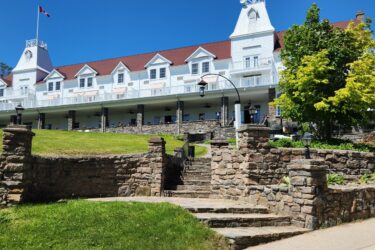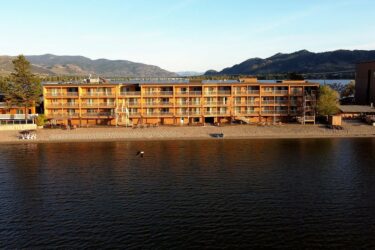
InnVest Hotels acquires The Algonquin Resort St. Andrews by‑the‑Sea, Autograph Collection and The Algonquin Golf Course
InnVest Hotels has acquired The Algonquin Resort St. Andrews by-the-Sea, Autograph Collection and The Algonquin Golf Course.
TORONTO — Brian Stanford of CBRE shared the latest statistics showing Canada’s position on the world stage, giving revised outlook numbers for 2020-2023, and looking at how the Canadian recovery might unfold.

TORONTO — CBRE changed the format for its quarterly update for this very unusual period in time. While the update typically looks at Canada and drills down into key metrics in each province and major cities within those provinces, this time they included a macro look at where Canada stands compared to other countries, how Canada has fared during previous downturns, a revised outlook for the years 2020 to 2023, and what the shape of the recovery will be.
The report also looked at the economic impact on the G7 countries in 2020 and 2021. Canada is facing the impact of COVID-19 along with the oil price war that impacts Alberta’s energy sector. As a result the negative results in 2020 are greater than anywhere else except Italy. Canada faces a more anemic Q3 and Q4 performance, largely because of the drag of the oil sector. As a consequence, the recovery will be more robust in 2021.
CBRE participates in weekly calls with our opposite numbers at CBRE around the world, and based on these calls it would seem that the government response in Canada has been much more aggressive than elsewhere in the world. Bank of Canada has cut interest rates to the lower end of the range to 0.25 per cent. The level of stimulus package currently includes about $227 billion or about 10 per cent of GDP. This level of stimulus is about 2.5 times larger than the government response to the 2009 financial crisis.
The purpose of the report was to look at how we are dealing with this pandemic and how we should plan going forward, Brian Stanford told CLN.
“We realized by the end of the day that the disease is going to dictate how this unfolds. We added a view of where we are at in Canada. Smaller provinces, less affected by COVID-19, can be a bit more flexible.”
Another big variable is how consumers will react to wanting to travel and staying in hotels, and what we’re allowed to do, Stanford added.
“All these factors are in there as intangibles.” For example, Magna research regarding travel intentions found that post-COVID, 67 per cent of respondents said they would never travel on a cruise.
In terms of the economic situation, hotels will be watching every penny. “Just because someone turns the lights on, doesn’t mean we’re back to normal. We see 2021 as being a big rebound. We know it’s going to be bad this year; there will be some recovery next year. This is the time of the greatest uncertainty I’ve ever seen,” said Stanford.
In the time leading up to the pandemic, the industry was seeing all-time highs in occupancy, RevPAR had slipped a little in 2019 compared to 2018, but it was still the second best year ever on a top line basis and even a bottom line basis at $15,000 per room. “We were coming in at all time highs,” Stanford said. “Growth was a bit moderated, but that kept things in check. One of the big influences will be how and what happens to the market and where the sources of growth will come.”
The monthly data and year-to-date figures don’t tell the whole story for March 2019 versus March 2020, as all the impact of COVID-19 came in the last half of the month, but weekly data from STR show that change. Right now, the hotels are at or about 15 per cent occupancy, and that’s probably a bit overstated as it doesn’t account for closed hotels or inventory not reporting in the market, Stanford said.
CBRE compared ADR and RevPAR during other downturns. ADR took awhile to recover in each case, and RevPAR took even longer. If you look at ANOI recovery, post 9/11 2001 had the smallest drop, 2002 showed modest returns and 2003 (SARS) was disastrous. “It was 2006 before we got back to 2000 levels,” said Stanford.
“It’s easy to say that is due in a large part to ADR, but hotels were catering to different demand sources. For example, a downtown Toronto hotel might have got great rates from conferences, but found demand was coming back but in the form of leisure stays for a broader GTA market, requiring creative packaging and pricing.”
The information showing ANOI over the past 20 years is even more telling. While SARS and 9/11 took three years to recover; for 2008, it took until 2015 to get back to the profits seen in 2007. In 2009 versus 2008, RevPAR for Canadian hotels declined by 10 to 20 per cent, while NOI per room declined more dramatically, from $11,142 per room to $8,006.
“We believe that this time we will see a 15 per cent ADR shortfall in 2020 compared to 2019,” Stanford said. “For full-service properties, that will be 33 per cent.”
CBRE expects demand will be off 40 per cent this year; 2021 will see a partial recovery; by 2022 the hotel sector will be almost recovered; and full recovery will take place in 2023. “We think the ADR recovery is going to be slow,” said Stanford. It will be 2023 before hotels get back to 2019 ADRs.
For these predictions, there’s a major assumption hat a vaccine will be in place no later than fall 2021. If there is no vaccine, we will be stuck in 2021 for some time, Stanford said. “Even after easing the restrictions and the lockdown, we will not see International travellers, we will not see U.S. travellers and a significant part of the economy will not want to travel. In July and August of 2021, we see occupancy not even hitting 50 per cent. Hopefully we will be in a better positioning the fall of the year, which is traditionally a weaker time.”
Meeting and conference business will not be coming back in 2020. “I can’t even imagine,” said Stanford. “How many events can a hotel host consisting of 200 people in a room for 500 people — if in fact people choose to go.
“Until we start to hit summer 2021, and there is a vaccine in place, we don’t start closing the gap until the latter part of 2021. There’s a protracted recovery on ADR, consistent with other downturns. The RevPAR gap is far greater because it combines the ADR and occupancy gaps.
What will life look like post-COVID?
“In the long term, there will be changes, but not as dramatic as people think,” Stanford said. “There is an overwhelming concern regarding the infection, even a general change in attitude. There will be a reduction of services; rooms will have to be disinfected even before the housekeepers go in. There’s so much speculation. For everybody, there will be increased costs.”
For the full report click here.



InnVest Hotels has acquired The Algonquin Resort St. Andrews by-the-Sea, Autograph Collection and The Algonquin Golf Course.

The new owners of the famed Windermere House hotel and resort on Muskoka’s Lake Rosseau intend to revitalize the building and its amenities while preserving the property’s historical integrity.

Proactive Hospitality has acquired the Coast Osoyoos Beach Hotel, B.C. CFO Capital arranged acquisition financing for the deal.

Tribute Portfolio – part of Marriott Bonvoy's extraordinary portfolio of 31 hotel brands – continues to grow its global family of characterful hotels with Honeyrose Hotel Montreal, a Tribute Portfolio Hotel, the brand's…